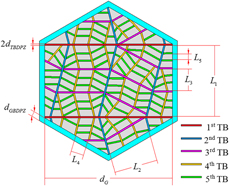Article contents
Size effect on mechanical properties in high-order hierarchically nanotwinned metals
Published online by Cambridge University Press: 21 January 2019
Abstract

Theoretical models for the strength and ductility of high-order hierarchically nanotwinned metals are developed, and especially analytical expressions of mechanical parameters with various influencing factors are deduced. Furthermore, the size effect on mechanical properties is analyzed based on these mechanism-based plasticity models, wherein the effects of twin spacing and grain size on the strength and ductility are discussed systemically. Related analysis demonstrates that the twin spacing plays an important role. Through adjusting the twin spacing of the primary layer of twin lamellae and optimizing the combination of twin spacing of the high-order layers, expected mechanical properties with high strength and high ductility could be achieved. Besides, the grain size also has a significant effect, and the reduction in grain size still induces a positive effect on the strength, whereas a negative effect on the ductility. Finally, a material design approach for the optimization of comprehensive mechanical properties is suggested.
- Type
- Invited Paper
- Information
- Journal of Materials Research , Volume 34 , Issue 13: Focus Issue: Intrinsic and Extrinsic Size Effects in Materials , 15 July 2019 , pp. 2177 - 2193
- Copyright
- Copyright © Materials Research Society 2019
References
- 7
- Cited by




